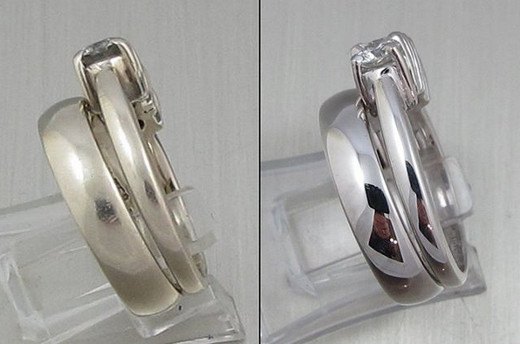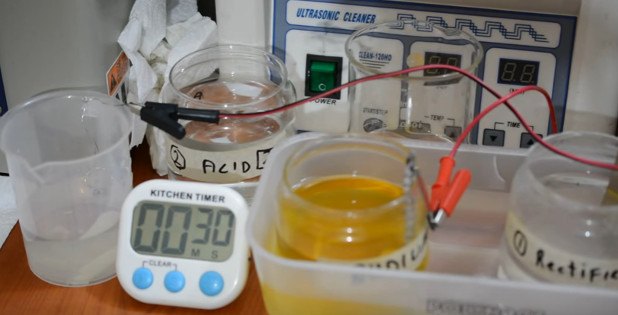Most people have seen rhodium-plated jewelry advertised. However, few understand what the rhodium plating process involves and how much it costs. In this article will explain the plating process as well as the pros and cons of getting your jewelry rhodium-plated.
- What Is Rhodium?
- What Is Rhodium Plating?
- The Rhodium Plating Process
- How Long Does Rhodium Plating Last?
- Pros and Cons
- Is Rhodium Jewelry Safe to Wear?
What Is Rhodium?
Rhodium is a valuable precious metal that is generally over two times more expensive than gold. It's a member of the platinum group, along with ruthenium, palladium, osmium, and iridium.
Rhodium is delicate and can be easily damaged. For this reason, it's rarely used to manufacture jewelry. Instead it's relied upon to enhance jewelry composed of stronger materials.
What Is Rhodium Plating?

Rhodium is often used to coat jewelry. This is known as "rhodium plating". You may also hear it referred to as "rhodium dipping" or "rhodium flashing". Rhodium plating makes a piece of jewelry more resilient to scratches and enhances its appearance with a reflective white finish. Rhodium plating is particularly pleasing to the eye when paired with extravagant jewelry. If you coat a diamond ring with a layer of rhodium then the diamond will look brighter.
Rhodium plating is most commonly found on white gold jewelry. You might also see it on alternative materials such as platinum and silver. In addition to protecting silver jewelry from scratches and scrapes, rhodium plating prevents it from tarnishing. Some people use rhodium plating to protect their yellow gold jewelry, but this is not always the best idea. Rhodium plating wears away over time, and a fading rhodium coat will leave yellow gold jewelry looking murky and discolored.
The Rhodium Plating Process

The rhodium plating process doesn't take a lot of time. A professional can complete a full rhodium dip in less than 90 minutes. But this doesn't mean that it's an easy process.
Correct rhodium plating follows a very specific electroplating formula. The process begins with the cleaning of the piece of jewelry in question. When cleaning jewelry for rhodium dipping, it's not enough to simply place it in a bowl of water. If there is the slightest speck of dirt on a piece of jewelry then a rhodium coat will not stick to it. For this reason, a thorough cleaning is necessary. Some jewelers do the cleaning with distilled water while others prefer steam cleaning. A number of jewelers even turn to electrocleaning. All methods are effective and acceptable. The most important factor is that anything which may prevent the rhodium from sticking is removed.
Once the cleaning is complete, a rhodium solution is prepared. The jewelry is then dipped into this solution and a positive electrical charge fuses the two together. This is the most complicated part of the rhodium plating process, and something could easily go wrong at this point. If the electrical charge is too high, then the plating will turn black. This is why you should always go to a seasoned professional. A hobbyist jeweler who has not mastered the rhodium plating process could potentially damage your jewelry beyond repair.
How Long Does Rhodium Plating Last?
Don't make the mistake of assuming rhodium plating is permanent. While a correctly applied rhodium coat can last for an extended period of time, it will inevitably fade. Most rhodium-coated jewelry requires re-plating every 12 to 18 months.
You can take a few preventive measures in order to prolong the life of a rhodium coat. Sprays like deodorant, aftershave, and perfume can wear away rhodium coating. So take off any rhodium-plated jewelry before applying them. Frequent contact with water may also expedite the demise of a rhodium coat. Therefore you should remove rhodium-plated jewelry before washing your hands, showering, or swimming.
Pros and Cons
There's no denying the advantages of rhodium plating. However, it's also not without its fair share of drawbacks. We'll examine the pros and cons of having your jewelry rhodium coated.
Pros
There are quite a few pros to having your jewelry rhodium plated. Learn about them below.
Resilient
Most people choose to have their jewelry rhodium plated because it ensures longevity. Rhodium is resistant to scratches and scrapes. When applied to a ring or similar piece of jewelry, it protects it from the most common threats.
Hypoallergenic
One of the major advantages of rhodium is that it's hypoallergenic. It contains no nickel and is devoid of virtually all other harmful materials commonly used in jewelry. For this reason, a rhodium coat is unlikely to cause or aggravate skin conditions.
Visual Appeal
A rhodium coat enhances the visual appeal of a piece of jewelry. By reflecting light, a rhodium coat makes jewelry appear to shine brighter. It also reduces blemishes and slows tarnishing.
Cons
Below are the cons related to rhodium plating.
Expensive
As mentioned, rhodium is over two times more valuable than gold. Therefore rhodium plating can be fairly expensive. Having a ring rhodium plated will cost you around $100, and in some cases the cost will exceed that. As noted previously, rhodium plating wears off after a couple of years. This means that you would have to spend another $100 to re-plate your piece of jewelry.
Limited Availability
If you live in a city, then you probably won't have any trouble finding a jeweler who offers rhodium plating. However rhodium plating is less common in small towns. Independent jewelers don't always provide the service. So if you can't access rhodium plating where you live, then you'll have to take your business out of town. You always have the option of mailing your jewelry away to a jeweler who offers the service. However, many are reluctant to do so for fear of their jewelry being lost in the mail.
Is Rhodium Jewelry Safe to Wear?
Certain metals used in jewelry may aggravate skin issues. A lot of jewelry contains nickel, a known allergen which can cause dermatitis. Thankfully, rhodium is hypoallergenic. It contains no harmful substances and is therefore safe to wear. However it's important to remember that rhodium plating does not counteract the effects of allergens. If a piece of jewelry contains nickel, then it may cause skin irritation regardless of rhodium plating.
Conclusion
Rhodium plating is an effective means of protecting jewelry from scratches and blemishes. While not strictly necessary, it's recommended for expensive pieces of jewelry that are worn on a regular basis. Engagement and wedding rings, for example, are often coated in rhodium solution.
Rhodium plating will almost always cost you more than $50. A thick rhodium coat may cost you as much as $200. For this reason, many people are reluctant to have their jewelry rhodium coated. But In the long run, it may prove the most affordable option. Having a piece of jewelry re-plated every few years can be less expensive than repairing or replacing it when damaged.
